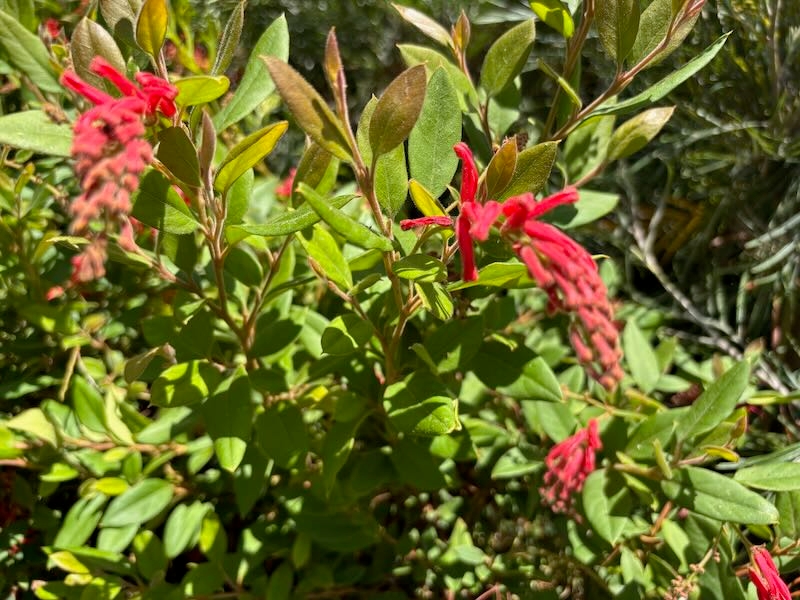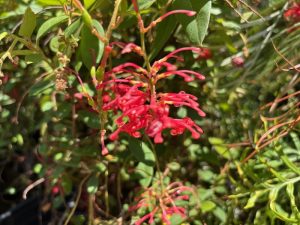Fire and Foliage: Grow Grevillea rhyolitica ‘Deua Flame’ for Year-Round Nectar
Grevillea rhyolitica ‘Deua Flame’ opens gardens with bright, spider-like red flowers and dense, olive-green foliage. Gardeners prize this Australian selection for its near-continuous bloom, its wildlife value, and its low-maintenance habits. It belongs to the Proteaceae family, and it performs especially well in sunny, well-drained sites. Read on to learn how to plant it, grow it, and use it to attract birds and pollinators.
Common names and synonyms gardeners use include Grevillea, Deua Flame Grevillea, Grevillea rhyolitica, and simply Deua Flame. For clarity, the scientific name is: Grevillea rhyolitica‘Deua Flame’.
Why Grevillea rhyolitica ‘Deua Flame’ deserves a spot in your garden
Plant Grevillea rhyolitica ‘Deua Flame’ if you want a compact shrub that flowers heavily without fussy soil feeds. Unlike many showy shrubs, ‘Deua Flame’ adapts to lean soils and still rewards you with vivid red inflorescences. Moreover, it attracts honeyeaters and nectar-feeding insects, making it a magnet for wildlife. Therefore, it works well in pollinator gardens, coastal beds, or xeriscapes where water conservation matters.
The cultivar traces to plants growing on rhyolite outcrops in southern New South Wales, Australia. Gardeners and selectors favored a rounded form with an exceptionally long flowering period and named that selection ‘Deua Flame’. The result gives you the drama of scarlet blooms without the mess of heavy seed set or aggressive suckering.
Appearance and growth habit
Grevillea rhyolitica ‘Deua Flame’ forms a dense, rounded shrub. Expect 1–1.5 m (3–5 ft) in height and roughly the same in spread under favorable conditions. Stems branch freely; they create a compact silhouette that requires little structural pruning.
Leaves appear lance-shaped and soft compared with many grevilleas. Their olive to mid-green tone complements the flame-red flower clusters that hang in pendulous racemes at branch tips. Birds and bees often feed while flowers still open, so you’ll see activity throughout the long bloom season.
Flowering season and wildlife value
‘Deua Flame’ flowers most heavily in late spring and summer, yet it produces intermittent blooms almost year-round in mild climates. Because the blossoms supply abundant nectar, native honeyeaters, hummingbirds in similar climates, and numerous pollinating insects visit repeatedly. Thus, this grevillea plays a strong ecological role in garden habitats.
How to Grow Grevillea rhyolitica ‘Deua Flame’
Plant it with care and you’ll enjoy a vigorous, low-care shrub. Below you’ll find short, focused subsections to guide you through site selection and routine care.
Light
Plant Grevillea rhyolitica ‘Deua Flame’ in full sun for the best flowering. It tolerates light shade, particularly in very hot inland sites, but flowering will reduce if shade becomes heavy. Place it where morning sun reaches the canopy and afternoon light does not scorch leaves.
Soil
Plant it in sharply drained soil. Grevilleas originate on poor, well-drained soils and resent wet feet. Use sandy loam, gritty loam, or a raised bed if your garden soil compacts. For clay soils, amend heavily with sharp sand and organic matter and consider planting on a slight mound to boost drainage.
Avoid general-purpose high-phosphorus fertilizers. Instead, use a low-phosphorus native plant fertilizer sparingly if the shrub shows nutrient stress. Otherwise, it will thrive on the natural fertility typical to its native habitat.
Watering
Water new plants regularly during the first 12–24 months to establish roots. After establishment, reduce irrigation. Mature plants tolerate drought and thrive on deep, infrequent watering. In summer heat, water deeply every two to four weeks depending on conditions, rather than daily shallow watering that encourages weak roots.
Fertilizer
Feed only if growth slows or foliage pales. Use a slow-release native plant fertilizer with low phosphorus. Apply once in early spring and again in late autumn only if the shrub needs a boost. Over-fertilizing encourages soft growth and reduces disease resilience.
Planting and spacing
Space plants about 1–1.5 m (3–5 ft) apart to form a dense screen or hedge. Dig a hole only as deep as the root ball, and wider to allow roots to spread. Mix some coarse sand or gravel into the backfill to ensure drainage. Plant so the root crown sits at soil level, then mulch lightly to conserve moisture while avoiding build-up around stems.
Pruning
Prune lightly after a heavy flush of flowers to maintain shape and encourage denser branching. Remove dead or crossing branches to improve airflow. Avoid cutting back into old, leafless wood because many grevilleas do not reshoot reliably from old wood. Therefore, keep pruning conservative and regular rather than severe and infrequent.
Container growing
You can grow ‘Deua Flame’ in large containers. Use a free-draining potting mix with added grit. Place pots in full sun and water more frequently than in the ground. In winter, protect containers from hard frosts by moving them to a sheltered spot.
Propagation and establishment
Propagate Grevillea rhyolitica ‘Deua Flame’ by semi-hardwood cuttings for true-to-type results. Take cuttings of 6–10 cm (2.5–4 in) in late summer or early autumn. Dip cut ends in rooting hormone and insert into a free-draining mix of coarse sand and peat. Keep them warm and humid until roots form.
Avoid seed propagation if you want the exact cultivar traits. Seedlings can vary because the species shows genetic diversity. If you must use seed, expect variations and do not rely on seed for cultivar fidelity.
Pests, diseases and troubleshooting
Monitor regularly for common pests. Aphids, scale insects, and occasionally borers can affect Grevilleas. Treat minor aphid and scale outbreaks with a strong jet of water or insecticidal soap. For borer problems, remove affected branches promptly and dispose of infested material.
Root rot develops when the soil remains waterlogged. If leaves yellow and wilt despite watering, check drainage first. Improve soil structure and reduce irrigation frequency to correct moisture problems.
Some grevilleas cause contact dermatitis in sensitive people. Therefore, wear gloves and long sleeves while pruning or handling this shrub.
Landscape uses and design ideas with Grevillea rhyolitica ‘Deua Flame’
Place ‘Deua Flame’ as a low hedge, an informal screen, or a specimen accent. Its compact habit suits cottage gardens and native plantings as much as modern xeriscapes. Because it resists coastal salt spray and wind, use it in seaside borders where many other shrubs struggle.
Combine it with silvery or fine-textured plants like Lavender, Eremophila, or ornamental grasses to set off the red flowers. Also, group it with other low native shrubs to create layered habitat for birds.
In containers, plant it with shallow-rooted annuals for summer color. Or use it near walkways and patios where you can enjoy visiting birds.
Design caution and tips
Do not plant Grevillea rhyolitica ‘Deua Flame’ in heavy shade. It will stay leggy and flower sparsely. Also, avoid planting where water pools after storms. Finally, if you live in a cold climate with hard frosts below −4°C (25°F), choose protected microclimates or grow it in pots that move under cover for winter.
Sourcing and cultivar notes
Nurseries and native plant societies typically list ‘Deua Flame’ in their grevillea selections. Because it remains a selection of a threatened wild species, buy from reputable growers that propagate responsibly. When searching, use both the botanical name and common name tags: Grevillea rhyolitica ‘Deua Flame’, Deua Flame Grevillea, or simply Deua Flame.
Final thoughts on Grevillea rhyolitica ‘Deua Flame’
Plant Grevillea rhyolitica ‘Deua Flame’ to add sustained color and wildlife value with minimal fuss. It rewards placement in sun and sharp drainage with months of nectar-rich flowers. Meanwhile, it stays compact, neat, and attractive, so you spend less time maintaining and more time enjoying the birds it attracts.



